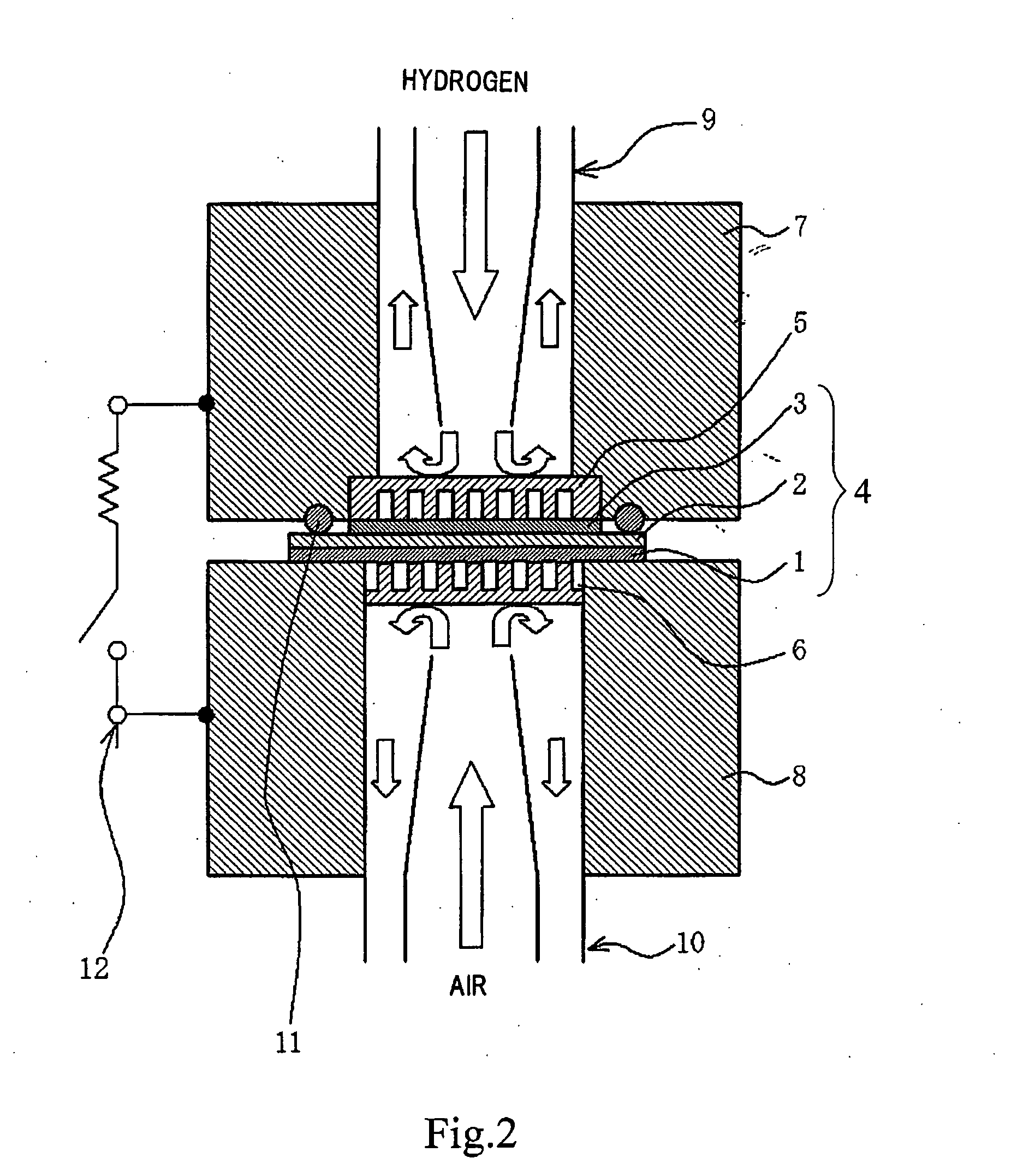Ion-Dissociative Functional Compound, Method for Production Thereof, Ionic Conductor, and Electrochemical Device
a functional compound and ion dissociation technology, applied in the direction of non-metal conductors, non-aqueous electrolyte cells, sustainable manufacturing/processing, etc., can solve the problem of insufficient heat resistance and/or chemical decomposition resistance, nafion tends to decrease in protonic conductivity, and materials shown in figs. 3b to 3d are still poor in heat resistan
- Summary
- Abstract
- Description
- Claims
- Application Information
AI Technical Summary
Problems solved by technology
Method used
Image
Examples
example 1
Preparation of an Ion-Dissociative Functional Compound of Fullerene Monomer
[0044]This example demonstrates the synthesis of poly(difluorosulfomethyl)fullerene C60 as the proton-dissociative functional compound by the process which consists of reacting fullerene C60 with difluoroiodomethanesulfonylfluoride CF21SO2F and hydrolyzing the resulting product.
[Synthesis of difluoroiodomethanesulfonylfluoride]
[0045]The same method as proposed by Chen Qing-Yuu in ACTA. CHIMICA. SINICA., 48 (1990), 596 or by N. D. Volkov et al., in Synthesis, 1979, 972 was followed to synthesize the difluoroiodomethanesulfonylfluoride-1-CF2—SO2F to be reacted with fullerene C60.
Method of Chen Qing-Yuu:
[0046]The first step was to synthesize silver difluoro(fluorosulfonyl)acetate from difluoro(fluorosulfonyl)acetic acid according to the reaction formula below.
[0047]Silver carbonate (5.0 g or 18.2 mmol) was dispersed into diethyl ether at room temperature. To the dispersion was slowly added dropwise with stirring...
example 2
Preparation of an Ion-Dissociative Functional Compound of Fullerene Polymer
[0079]This example demonstrates the process of synthesizing a solvent-insoluble proton-dissociative functional compound of fullerene polymer by the following four steps. The process consists of reacting fullerene C60 with difluoroiodomethanesulfonylfluoride (in the same way as in Example 1), polymerizing the reaction product by conversion into sulfoneimide, and hydrolyzing the resulting polymer.
The First Step:
[0080]The first step is intended for reaction to introduce sulfonylfluoride groups into fullerene C60 (in the same way as in Example 1), thereby giving a first reaction product represented by the general formula C60— (CF2—SO2F)n (where n is about 10), according to the reaction formula below.
[0081]The first step is similar to that in Example 1 except for the fact that the sulfonylfluoride group introduced into the first reaction product is partly used to connect fullerene molecules to each other at the ti...
example 3
Evaluation of Heat Resistance by Analysis of Gas Evolved on Heating
[0093]An experiment was carried out to test the samples of proton-dissociative functional compounds obtained in Examples 1 and 2 and the samples of fullerene derivatives (for comparison) shown in FIGS. 3A to 3D for heat resistance by analysis of gas evolved on heating.
[0094]To start the experiment, the sample (about 20 mg) was placed in an open vessel. Then, the open vessel holding the sample was placed in a vacuum vessel capable of controlled heating. The vacuum vessel is provided with an RGA (Residual Gas Analyzer) to detect and analyze evolved gas. The RGA is capable of detecting a gas with a molecular weight of 1 to 300.
[0095]The vacuum vessel was evacuated to 10−7 Torr and heated to 500° C. at a heating rate of 4° C. / min. The gas that was evolved during heating was detected and analyzed. The analyte was SO2 or SO3 gas arising from decomposition of sulfonic acid groups. The temperature at which these gases are ev...
PUM
| Property | Measurement | Unit |
|---|---|---|
| thickness | aaaaa | aaaaa |
| proton conductivity | aaaaa | aaaaa |
| thickness | aaaaa | aaaaa |
Abstract
Description
Claims
Application Information
 Login to View More
Login to View More - R&D
- Intellectual Property
- Life Sciences
- Materials
- Tech Scout
- Unparalleled Data Quality
- Higher Quality Content
- 60% Fewer Hallucinations
Browse by: Latest US Patents, China's latest patents, Technical Efficacy Thesaurus, Application Domain, Technology Topic, Popular Technical Reports.
© 2025 PatSnap. All rights reserved.Legal|Privacy policy|Modern Slavery Act Transparency Statement|Sitemap|About US| Contact US: help@patsnap.com



